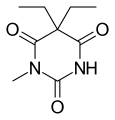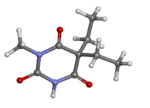Metharbital
 | |
 | |
| Clinical data | |
|---|---|
| Routes of administration | By mouth (tablets) |
| ATC code | |
| Legal status | |
| Legal status |
|
| Identifiers | |
| |
| Synonyms | Endiemal, metharbitone, methobarbitone[1] |
| CAS Number | |
| PubChem CID | |
| IUPHAR/BPS | |
| DrugBank | |
| ChemSpider | |
| UNII | |
| KEGG | |
| ChEMBL | |
| ECHA InfoCard | 100.000.011 |
| Chemical and physical data | |
| Formula | C9H14N2O3 |
| Molar mass | 198.219 g/mol |
| 3D model (JSmol) | |
| |
| |
| (verify) | |
Metharbital was patented in 1905 by Emil Fischer working for Merck.[2] It was marketed as Gemonil by Abbott Laboratories. It is a barbiturate anticonvulsant, used in the treatment of epilepsy.[3][4] It has similar properties to phenobarbital.
History
- 1952 Gemonil was introduced by Abbott Laboratories.
- 1990 Abbott stopped marketing.
Synthesis
Metharbital can be synthesized from 2,2-diethylmalonic acid and O-methylisourea.[5][6][7]
References
- ↑ The Comparative Toxicogenomics Database: Metharbital
- ↑ US Patent 782742
- ↑ The Treatment of Epilepsy 2nd Ed by S. D. Shorvon (Editor), David R. Fish (Editor), Emilio Perucca (Editor), W. Edwin Dodson (Editor). Published by Blackwell 2004. ISBN 0-632-06046-8
- ↑ The Medical Treatment of Epilepsy by Stanley R Resor. Published by Marcel Dekker (1991). ISBN 0-8247-8549-5
- ↑ A. Halpern, J.W. Jones, J. Am. Pharm. Assoc., 38, 352 (1949)
- ↑ Snyder, J. A.; Link, K. P. (1953). "Preparation and Characterization by Alkaline Methanolysis of 5,5-Diethyl-4-(tetraacetyl-β-D-glucosyloxy)-2,6(1,5)-pyrimidinedione". Journal of the American Chemical Society. 75 (8): 1881. doi:10.1021/ja01104a030.
- ↑ U.S. Patent 782,742
This article is issued from
Wikipedia.
The text is licensed under Creative Commons - Attribution - Sharealike.
Additional terms may apply for the media files.